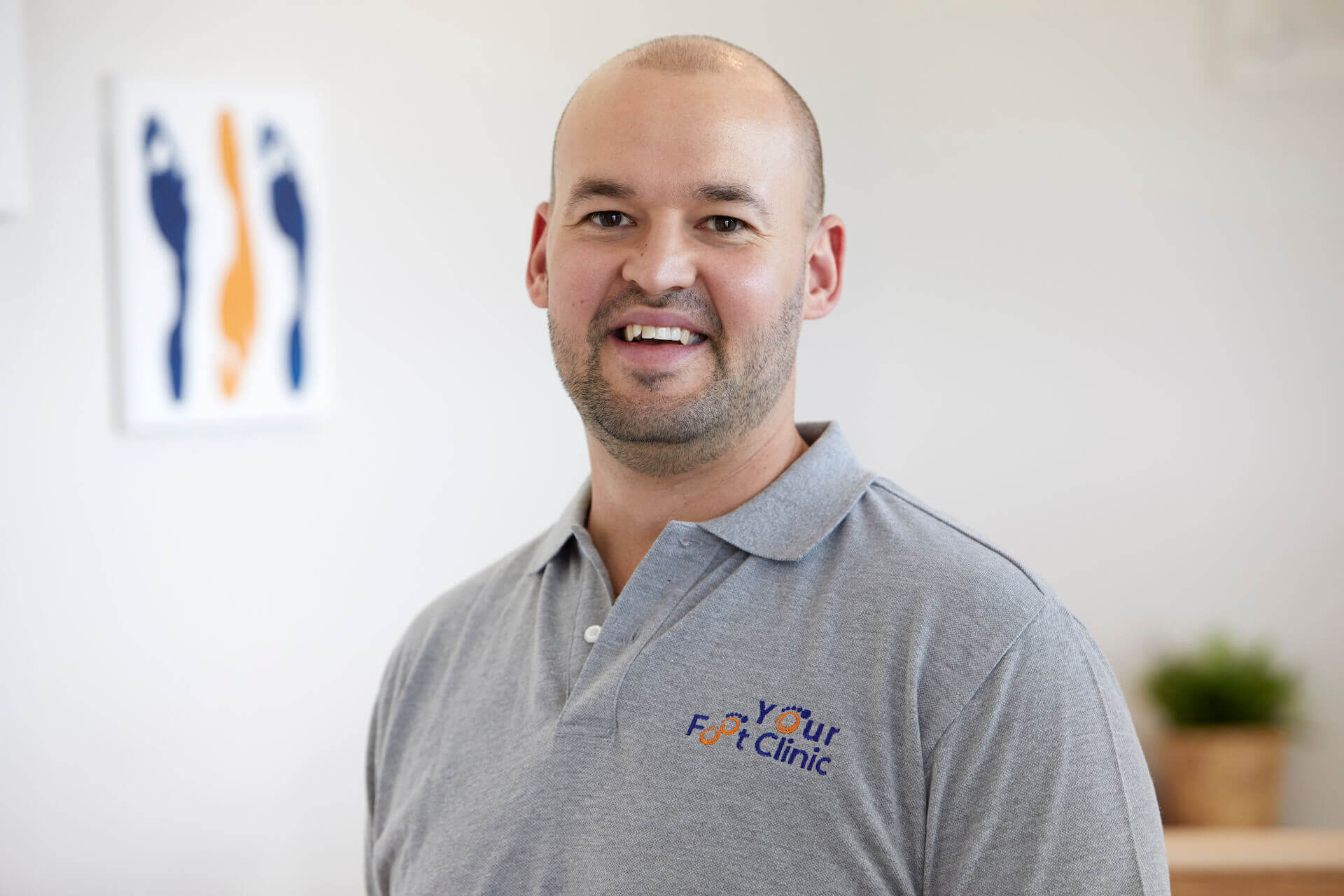We recently caught up with Foot and Running expert, Liam Rothwell, a Podiatrist from Your Foot Clinic in Ferntree Gully, to discuss his passion – FEET
In this Blog Liam give’s us tips to help relieve plantar fasciitis, the most common cause of heel pain, as well as tips to avoid common injuries when returning to exercise, particularly running, following isolation.
He also sheds light on the common footwear debate – read on to find out which is best ….
Liam, I know you’re really passionate about feet (which seems a little weird to me, but… sure), why is the foot such a big deal?
 Ha ha, thanks Trav. Well you’ve got to start somewhere and a lot starts with the feet. They’re the first things that hit the ground in the morning, they take your body weight when you stand and they help you move, walk, run and jump. As important as they are, feet are so easily neglected. They are shoved into the wrong types of shoes, they kick things, you stand on sharp objects with them and they unfortunately are prone to infections. They are often covered up so they are also rarely seen and for patients with poorly controlled diabetes, the feet may develop some complications hence why it is recommended to have them checked at least once a year.
Ha ha, thanks Trav. Well you’ve got to start somewhere and a lot starts with the feet. They’re the first things that hit the ground in the morning, they take your body weight when you stand and they help you move, walk, run and jump. As important as they are, feet are so easily neglected. They are shoved into the wrong types of shoes, they kick things, you stand on sharp objects with them and they unfortunately are prone to infections. They are often covered up so they are also rarely seen and for patients with poorly controlled diabetes, the feet may develop some complications hence why it is recommended to have them checked at least once a year.
Those who suffer from foot pain or problems often feel it with every step they take. This pain may be caused by nail or skin related issues or problems in the muscles, nerves and bones. Usually people can put up with a bit of discomfort, but we all have to stand and walk and so often the problems don’t resolve and we eventually see these patients attend our clinic. Sometimes the painful condition has turned chronic and we have to treat, manage and educate patients about how to become stronger, more resilient and pain free. Some conditions can be resolved with one session though and then patients leave feeling like they’re walking on a cloud!
Heel pain is a common problem, and is particularly frustrating for people trying to do the right thing and exercise.
Why does heel pain occur? and what tips do you have to relieve heel pain?
Heel pain is the most common musculo-skeletal injury that we see in our clinic. It unfortunately affects 1 in 10 people and has a huge physical and psychological impact on sufferers because of its chronic nature. It is typically worse when standing on your feet after a time of rest but can also become sore as the day goes on.
There are many factors that can cause heel pain but most are caused by a change in normal load patterns through the plantar fascia. In other words, there is more pressure on the plantar heel than it can tolerate.
The biomechanics of your feet can also cause the condition, for example if you have feet that roll in, it may cause the fascia to overstretch as the arch flattens. A high arched foot may also result in increased pressure on the heel, as the plantar fascia is generally tighter as it works hard to support a higher structure. Reduced ankle range of motion and calf muscle tightness or weakness can also result in tension on the plantar fascia.
Being overweight can also add extra load to the foot and is seen to be a major risk factor for plantar heel pain. Weakness of the muscles within the foot can result in increased pressure and a reduced shock absorption capacity of the foot and heel. Inappropriate shoes can also be a common cause of heel pain. If you’ve got calf tightness avoid flat shoes which can over stretch and stress the plantar fascia even more; if you’ve got poor shock absorption avoid thin soled shoes. Standing, running or jumping on hard surfaces can also cause heel pain as can walking up hills or stairs and working on ladders.
The common theme across these factors is that they all place extra stress on the plantar fascia.
If the pain is recent, treatments such as ice, rest, appropriate shoes or offloading techniques and anti-inflammatories may be helpful. If the pain has been present for weeks, treatments such as heat along with strengthening can be beneficial along with a tennis or golf ball massage. The aim is to reduce whatever pressure is causing the pain so wearing supportive cushioned footwear is usually recommended to make things more comfortable. Taping and orthotics may also be issued to assist with offloading stress to the area.
During our initial consultation with a patient who is suffering from heel pain we will assess, diagnose and develop a treatment plan depending on the cause. There are many options depending on the severity of the condition and the focus is on reducing the causes of stress on the feet in an effort to reduce the pain as quickly as possible and then plan on strengthening the foot and associated lower limb structures to prevent the problem from occurring again.
[READ MORE ABOUT HEEL PAIN]
Following and throughout the COVID-19 pandemic, a lot of people have started running as their form of exercise. What are your recommendations when starting running for the first time, to prevent injury or pain?
It has been great to see so many people and families out and about exercising. Hopefully this continues even with the relaxing of the restrictions. With the closure of gyms and the cessation of many sports, people have taken to running as their chosen exercise. But with the simple action of slipping the runners on and moving quickly comes the danger of getting injured.
My advice would be that if you’ve never run before to gradually build yourself up to the level and distance you want to achieve. Your body needs time to acclimatise itself to the stresses of running. To avoid injuries small increases in distance, pace and duration of runs needs to be adhered to. Always start off slow to warm up and then run comfortably for your desired distance, stopping if you need a break or feel sore.
There are other factors to consider whether you’re a seasoned runner or a beginner when you’re trying to avoid injuries. Making sure your runners are suitable for your running ability and what you want to achieve. The surfaces you run on should also be considered. Running on a grass oval is a lot more forgiving than pounding the concrete pavement but not as challenging as some of the awesome hills and trails we have access to in our community.
One of my friends had shin splints and was recommended to see a Podiatrist. How does a Podiatrist help with shin splints?
Shin splints is a general term for the condition medial tibial stress syndrome (MTSS). There are many factors that can cause stress on the lower third of your leg but usually patients who get referred to us are found to have a problem with the biomechanics of their feet. Mostly these patients are runners or play sports that involve running or jumping.
We assess how the foot functions with running and walking as well as the muscles that run through the lower leg and into the foot. Usually there is a tightness or weakness in some of these muscles which results in irritation to the inside of the tibia. The other theory with shin pain is that when running the impact from hitting the ground causes a bending force on the lower leg. With these two options being the most likely causes for this injury it is often a good idea to have an assessment of your feet from a podiatrist as they have such a big role to play.
As well as foot function there are many other possible reasons for developing shin splints. The surfaces you run on plays a big role with harder surfaces more likely to cause bending force and overuse of muscles. The shoes you wear may at times not be appropriate for your feet or activity. The most common cause of shin pain though is patients doing too much activity too quickly, hence why we see a lot of patients present to us with this in pre-season training for many sports.
Once we’ve performed our assessments and worked out what is causing the pain we’ll determine the right management and treatment plan to reduce the stress on the tibia and strengthen the feet and legs so that they can withstand the load and pressures placed on them.
There’s always a lot of debate about which shoes are best for runners and sports people alike. What should we be looking for in a shoe?
Your shoes are very important and should really reflect your running/sporting ability and requirements. With such variations in support, cushioning, weight, stiffness, heel drop etc. there are so many options out there to accommodate for the large variations in feet and running abilities. My advice is choose the shoe that is most comfortable for you. This includes most importantly the fit for your feet but also the feel when walking and running. This may be hard to discover quickly so we often refer our patients to stores such as The Running Company in Lilydale or Active Feet in Heathmont who allow customers to try on a variety of runners and give advice while they walk/run on a treadmill. Athletes Foot also have a deal which allows you to trial your shoes for a month and if you’re not happy, and you haven’t damaged the shoes you can return them for another pair. We always encourage people to get properly fitted as we often see many foot and leg injuries that are a direct result of inappropriate footwear.
[READ MORE ABOUT HOW TO CHOOSE THE RIGHT SHOE]
Liam is one of the Directors and a Podiatrist at Ferntree Gully Foot Clinic, part of the Your Foot Clinic group
To learn more about managing heel pain READ MORE
To learn more about what a Podiatrist can help you with READ MORE

